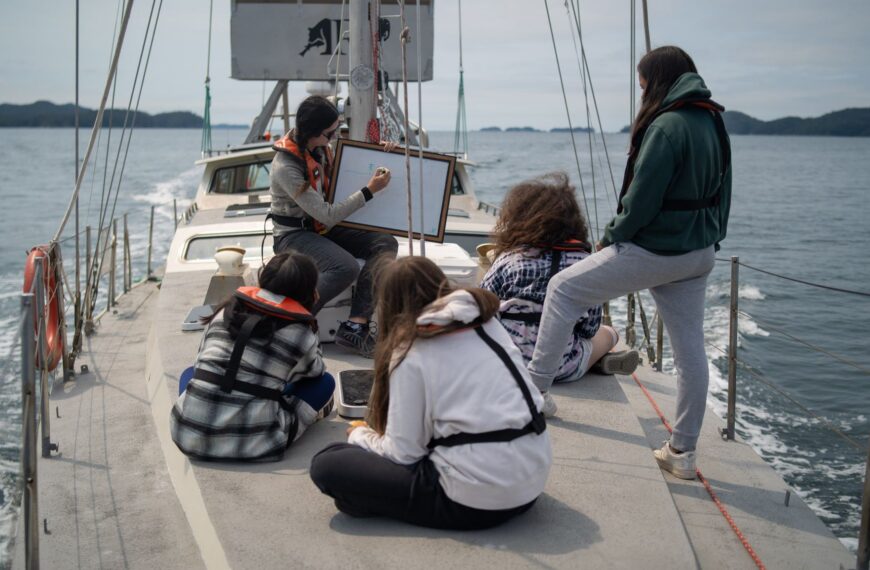Predictions from machine learning ensembles: marine bird distribution and density on Canada’s Pacific coast
For conservation efforts targeting marine birds to be effective, quantitative information relating to their at-sea density and distribution is typically a crucial knowledge component.
In February of 2017, a team of researchers from five research facilities published their findings in Marine Ecology Progress Series: “Predictions from machine learning ensembles: Marine bird distribution and density on Canada’s Pacific coast”. The study was authored by Drs. Caroline Fox (previously Raincoast Conservation Foundation), Paul Paquet (Raincoast Conservation Foundation), and Falk Huettmann (University of Alaska), in addition to Gillian Harvey (who completed her MSc in collaboration with Raincoast Conservation Foundation), Jill Robinson (Habitat Acquisition Trust), Ken Morgan (Environment and Climate Change Canada), and Rob Williams (Oceans Initiative).
Read the full article [icon icon=”external-link”] Get the PDF [icon icon=”external-link”]
“Despite the aforementioned limitations and challenges, for many species and groups, this study provides the ‘best available’ information regarding their estimated at-sea distributions and densities in the study area. In conjunction with information on breeding colonies, MPAs, important bird areas, and other areas important for marine birds, this information can be used to inform emergency responses, assessments of risk (e.g. chronic oil pollution; Fox et al. 2016), MPA planning, MSPs, including the Marine Planning Partnership for the North Pacific Coast, and more.”
Abstract
Increasingly disrupted and altered, the world’s oceans are subject to immense and intensifying anthropogenic pressures. Of the biota inhabiting these ecosystems, marine birds are among the most threatened. For conservation efforts targeting marine birds to be effective, quantitative information relating to their at-sea density and distribution is typically a crucial knowledge component. In this study, we generated predictive machine learning ensemble models for 13 marine bird species and 7 groups (representing 24 additional species) in Canada’s Pacific coast waters, including several species listed under Canada’s Species at Risk Act. Predictive models were based on systematic marine bird line transect survey information collected in spring, summer, and fall on Canada’s Pacific coast (2005-2008). Multiple Covariate Distance Sampling (MCDS) was used to estimate marine bird density along transect segments. Spatial and temporal environmental predictors, including remote sensing information, were used in model ensembles, which were constructed using 4 machine learning algorithms in Salford Systems Predictive Modeler v7.0 (SPM7): Random Forests, TreeNet, Multivariate Adaptive Regression Splines, and Classification and Regression Trees. Predictive models were subsequently combined to generate seasonal and overall predictions of areas important to marine birds based on normalized marine bird species or group richness and densities. Our results employ open access data sharing and are intended to better inform marine bird conservation efforts and management planning on Canada’s Pacific coast and for broader-scale geographic initiatives across North America and elsewhere.
Citation
Fox, Caroline & Huettmann, FH & Harvey, GKA & Morgan, Ken & Robinson, J & Williams, Rob & Paquet, Paul. (2017). Predictions from machine learning ensembles: Marine bird distribution and density on Canada’s Pacific coast. Marine Ecology Progress Series. 566. 10.3354/meps12030.
DOI: 10.3354/meps12030
Online publication date: February 27, 2017
Print ISSN: 0171-8630; Online ISSN: 1616-1599
https://www.researchgate.net/publication/312073836_Predictions_from_machine_learning_ensembles_Marine_bird_distribution_and_density_on_Canada’s_Pacific_coast
Figure 2

Figure 3

Authors & Affiliations
Department of Geography, University of Victoria, Victoria BC, Canada
Caroline H. Fox, G. K. A. Harvey & P. C. Paquet
Raincoast Conservation Foundation, Sidney BC, Canada
Caroline H. Fox, G. K. A. Harvey, J. Robinson & P. C. Paquet
EWHALE lab, Biology and Wildlife Departments, Institute of Arctic Biology, University of Alaska-Fairbanks, AK, USA
F. H. Huettmann
Environment and Climate Change Canada, Sidney BC, Canada
K. H. Morgan
Oceans Initiative, Seattle WA, USA
R. Williams
Department of Oceanography, Dalhousie University, Halifax NS, Canada
Caroline H. Fox
Habitat Acquisition Trust, Victoria, BC, Canada
J. Robinson
Acknowledgements
Support for marine bird surveys byRaincoast Conservation Foundation (RCF) and subsequent data analysis was provided by the Gordon and Betty MooreFoundation, the Marisla Foundation, the McLean Foundation, the Bullitt Foundation, Mountain Equipment Co-op,Patagonia, the Conservation Alliance, the Vancouver Foundation, the Russell Family Foundation, Environment andClimate Change Canada (ECCC), and RCF donors, volunteers, and others. H. Krajewsky, M. Price, and other marine bird observers and survey members are acknowledged for their contributions. We also thank D. Kawai for his contributions to data preparation and P. O’Hara and N. Serra-Sogas for the study hexagons and advice on environmental variables. Salford Systems Ltd provided SPM7 for this research via the EWHALE lab license to F.H. C.H.F was supported by an NSERC IRDF postdoctoral fellowship, G.K.H. and J.R. byRCF and the ECCC Science Horizons program, P.C.P. byRCF, and K.M. by ECCC. F.H. appreciates the support by UAF for the EWHALE lab, as well as S. Linke, H. Berrios Alvarez, and the project team of co-authors.
You can help
Raincoast’s in-house scientists, collaborating graduate students, postdoctoral fellows, and professors make us unique among conservation groups. We work with First Nations, academic institutions, government, and other NGOs to build support and inform decisions that protect aquatic and terrestrial ecosystems, and the wildlife that depend on them. We conduct ethically applied, process-oriented, and hypothesis-driven research that has immediate and relevant utility for conservation deliberations and the collective body of scientific knowledge.
We investigate to understand coastal species and processes. We inform by bringing science to decision-makers and communities. We inspire action to protect wildlife and wildlife habitats.










